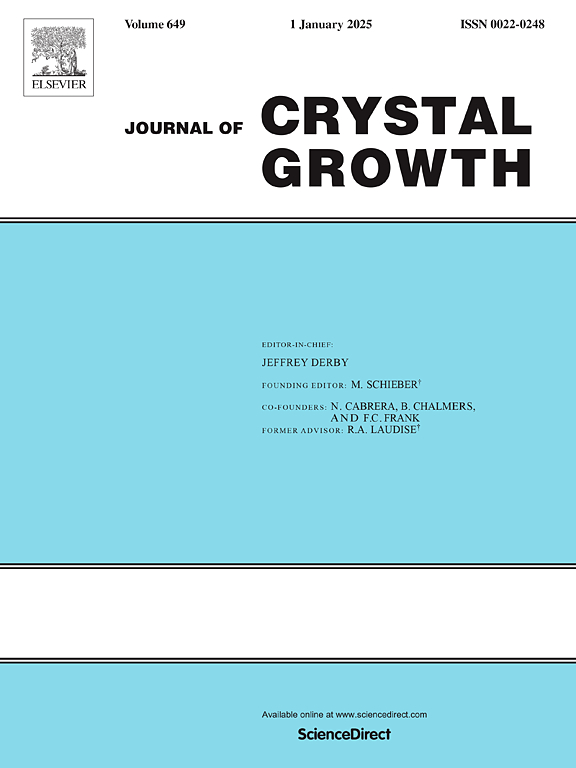Design of hard-shaft Czochralski growth furnace based on motion separation sealing for large-size monocrystalline silicon growth
IF 1.7
4区 材料科学
Q3 CRYSTALLOGRAPHY
引用次数: 0
Abstract
Czochralski growth process has been used for the fabrication of monocrystalline silicon, while the furnace vibration is always observed and seriously affect the quality of silicon ingots, especially for large-size monocrystalline silicon. This paper studied the structural design of hard-shaft monocrystal furnace by separating the axial and circumferential motions between the furnace chamber, the vibration caused by crystal rotation can be greatly reduced. With more stable pulling speed control, the furnace can achieve a uniform thermal field and temperature distribution on the growth interface for monocrystalline silicon growth with high quality. Then, numerical model was established to analyze the thermal field of the growth chamber and especially its influence on furnace vibrations. The vibration tests were conducted and results showed that the vibration acceleration of the growth furnace based on our designed motion separation sealing structure is extremely low. After that, 12-inch monocrystalline silicon growth experiments were conducted and the sliced silicon wafer was characterized. Characterization results showed that the oxygen content of the silicon wafer is low with the value of 7.5 × 1017 /cm3, the average resistivity is about 12.97 Ω·mm with a radial resistance variation of 3.79 %. The obtained results indicated that our designed hard-shaft monocrystal furnace could be used for high-quality large-size silicon growth production.
基于运动分离密封的大尺寸单晶硅生长用硬轴直拉生长炉设计
单晶硅的制备一直采用直克拉氏生长法,但在生产过程中经常观察到炉体振动,严重影响了硅锭的质量,尤其是大尺寸单晶硅。本文研究了硬轴单晶炉的结构设计,通过分离炉腔之间的轴向和周向运动,可以大大降低晶体旋转引起的振动。通过更稳定的拉速控制,可以实现生长界面上均匀的热场和温度分布,从而获得高质量的单晶硅生长。然后,建立数值模型,分析了生长室的热场,特别是其对炉膛振动的影响。进行了振动试验,结果表明,基于所设计的运动分离密封结构的生长炉振动加速度极低。然后进行了12英寸单晶硅生长实验,并对切片硅片进行了表征。表征结果表明,硅片的氧含量较低,为7.5 × 1017 /cm3,平均电阻率约为12.97 Ω·mm,径向电阻变化率为3.79%。结果表明,所设计的硬轴单晶炉可用于高质量的大尺寸硅生长生产。
本文章由计算机程序翻译,如有差异,请以英文原文为准。
求助全文
约1分钟内获得全文
求助全文
来源期刊

Journal of Crystal Growth
化学-晶体学
CiteScore
3.60
自引率
11.10%
发文量
373
审稿时长
65 days
期刊介绍:
The journal offers a common reference and publication source for workers engaged in research on the experimental and theoretical aspects of crystal growth and its applications, e.g. in devices. Experimental and theoretical contributions are published in the following fields: theory of nucleation and growth, molecular kinetics and transport phenomena, crystallization in viscous media such as polymers and glasses; crystal growth of metals, minerals, semiconductors, superconductors, magnetics, inorganic, organic and biological substances in bulk or as thin films; molecular beam epitaxy, chemical vapor deposition, growth of III-V and II-VI and other semiconductors; characterization of single crystals by physical and chemical methods; apparatus, instrumentation and techniques for crystal growth, and purification methods; multilayer heterostructures and their characterisation with an emphasis on crystal growth and epitaxial aspects of electronic materials. A special feature of the journal is the periodic inclusion of proceedings of symposia and conferences on relevant aspects of crystal growth.
 求助内容:
求助内容: 应助结果提醒方式:
应助结果提醒方式:


